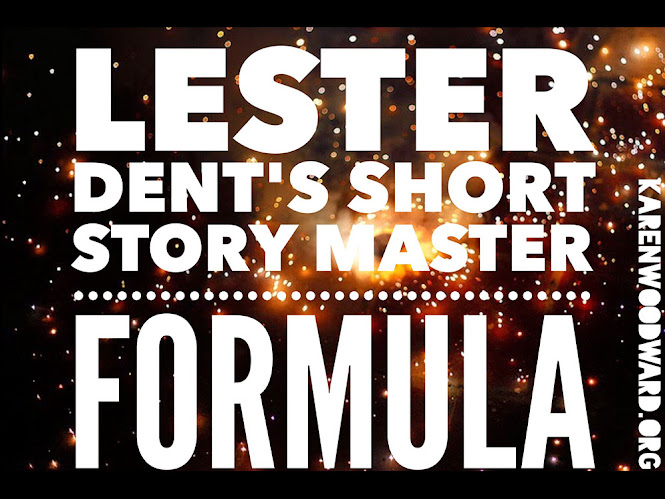This post continues my series on Lester Dent's Master Fiction Formula.
The First 1,500 Words
1a. Introduce your characters early and in action.
The first quarter of our 6,000 word story is mainly going to be concerned with introducing the characters, the setting and setting up the problem/mystery to be solved. Also--and I can't stress this enough--bring them on in action.
Dwight V. Swain writes:
The first time he appears, the character must perform some act that characterizes him.
Character can't be demonstrated save in action [...] [W]hen you act--ah, then the cards are down and we see the stuff you're really made of!
For this reason, you as a writer should devise incidents that will force your story people to reveal early--or at least hint at--their true natures, in action. Each must display, and thus establish, that aspect of himself which is of top importance to the story. Is your man a thief? Show him stealing. A scholar? Let him abandon the party for the library. Ambitious? Have him maneuver a chance to impress someone who can help him. (Techniques of the Selling Writer)
Excellent advice. I tell you, if push came to shove and I had to get rid of every single book on writing I possess save one, I think I'd keep Techniques of the Selling Writer.
Introduce all your characters early, not just your hero, and introduce them in action.
1b. Introduce your characters using tags and traits
A great way to introduce any character, but especially your hero, is through the use of tags and traits. [1]
Jim Butcher writes:
"TAGS are words you hang upon your character when you describe them. When you're putting things together, for each character, pick a word or two or three to use in describing them. Then, every so often, hit on one of those words in reference to them, and avoid using them elsewhere when possible. By doing this, you'll be creating a psychological link between those words and that strong entry image of your character.
. . . ."TRAITS are like tags, except that instead of picking specific words, you pick a number of unique things ranging from a trademark prop to a specific mental attitude. Harry's traits include his black duster, his staff, his blasting rod and his pentacle amulet. These things are decorations hung onto the character for the reader's benefit, so that it's easy to imagine Harry when the story pace is really rolling. (Characters)"
Here's how Lester Dent introduces Renny Renwick in his book, According to Plan of a One-Eyed Mystic:
Doc said, “This will be the first vacation you have had, Renny.”
“Yes. I'm slipping in my old age,” Renny said, grinning.
There was no truth in the statement, and they both knew it. Renny, with his great size, big fists, homely face, and his exclamation of, “Holy cow!” for every unusual situation, wasn't slipping. Not at all. The thing he still liked most was excitement.
That description was packed with information. We're told that Renny Renwick is getting on in years but isn't old. He's a workaholic. He's a big guy, not good looking but not ugly and he gets a saying: Holy cow. Also, even though he's getting on in years he's as capable as he ever was and he hasn't lost his thirst for excitement.
Dent delivered all that information in a few lines.
Here's another passage:
"Doc Savage was a giant bronze man whose appearance was almost as astonishing as his reputation. His bronze hair was only a little darker than his skin, and his eyes, one of his most spectacular features, were like pools of flake gold always stirred by tiny winds. He was obviously a man of great physical strength."
Tags:
- giant, strong, man
- bronze hair and skin
- startling appearance and reputation
- eyes "like pools of flake gold always stirred by tiny winds"
Dent's description was packed with information and was rolled out in a natural way.
Further reading:
- Jim Butcher's Livejournal: Characters.
- In June I wrote an article about Tags and Traits: Tags & Traits: Characterization And Building Empathy.
2. Put The Hero In Danger
In Dent's words the hero "tries to fathom the mystery, defeat the menace, or solve the problem" and, in so doing, he puts himself in danger.
Be clear on what the villain's goal is and on what the protagonist's goal is. What obstacles will the antagonist put in the hero's way to prevent him/her derailing his dastardly plans? How can the hero avoid these obstacles? How might the villain anticipate the hero's next move and use it to trip him/her up?
3. In the first paragraph, the first line, introduce the hero and "swat him with a fistful of trouble".
I don't know if this is the sort of thing Dent had in mind, but in one of my short stories I have my protagonist being shot at in the first paragraph, then I go back in time half an hour and show what led up to it.
I think the important thing is to introduce a question very early on, in the first paragraph if possible. In his article, A Simple Way To Create Suspense, author Lee Child writes:
"As novelists, we should ask or imply a question at the beginning of the story, and then we should delay the answer."
For example, here's the first line of J.K. Rowling's Harry Potter and the Sorcerer's Stone:
"Mr. and Mrs. Dursley, of number four, Privet Drive, were proud to say that they were perfectly normal, thank you very much."
The question: What is abnormal and why are they making such a fuss about being normal?
It doesn't hurt that J.K. Rowling inhabits her prose. What a voice! But, moving on.
Another great first line comes from Stephen King's It:
"The terror, which would not end for another twenty-eight years--if it ever did end--began, so far as I know or can tell, with a boat made from a sheet of newspaper floating down a gutter swollen with rain."
There's a terror, one that may never have ended, and it begins with something as innocuous as a newspaper boat. That kept me reading!
Granted the examples I've used come from novels, but it is the same principle. The important thing is to, in your very first sentence, place a question in the readers mind they would like the answer to.
A word of warning, though. This implied question carries a promise: that it will be answered and that the answer will have been worth the wait.
In both It and the first Harry Potter book we're given, fairly early on, a good idea what the answers are. What's abnormal? Harry and his ilk. What's the terror? It lives in the rain-swelled gutters, looks like a clown and likes to snack on little children.
4. End with a twist
A plot twist "is a radical change in the expected direction or outcome of the plot of a novel [...] It is a common practice in narration used to keep the interest of an audience, usually surprising them with a revelation." (Plot twist, Wikipedia)
Examples of plot twists:
- Darth Vader revealing himself as Luke Skywalker's father in The Empire Strikes Back.
- Arch villain Keyser Soze turns out to be the unreliable narrator in The Usual Suspects.
- In The Sixth Sense the protagonist and point of view character turns out to be a ghost.
For more great plot twists peruse Wikipedia's list of plot twists.
Traditionally--looking at stories through the framework of the three act, eight sequence, structure--a plot twist (or plot reversal) occurs at the 25% mark and the 75% mark.
For instance, at the 25% mark of Indiana Jones and Raiders of the Lost Ark Indy finds out that his mentor--the man who had the artifact he wanted--is dead. His daughter, a former lover of his and a women who really knows how to hold a grudge, was in possession of it.
At the 25% mark of Harry Potter and the Sorcerer's Stone Harry finds out he's a wizard and is whisked off to Hogwarts. (The 25% mark is, roughly speaking, where the hero is locked into their adventure.)
Intensify the mystery
At their heart, I think all of Lester Dent's stories--like J.J. Abram's stories--were about mysteries. So, as Dent writes, it's important to "hint at a mystery, a menace or a problem to be solved--something the hero has to cope with".
Our checklist for what we need to have accomplished so far:
a. "Does it have SUSPENSE?"
b. "Is there a MENACE to the hero?"
c. "Does everything happen logically?"
By the end of the first quarter of the story we need to have accomplished something. The hero needs to rescue someone, or find something out. Let's say the hero needs to rescue someone named Eloise and ...
"... surprise! Eloise is a ring-tailed monkey. The hero counts the rings on Eloise's tail, if nothing better comes to mind.
They're not real. The rings are painted there. Why?"
Another mystery is introduced. The key point is to send the story off in a new direction.
That's it for the first quarter! Next time we'll take our story up to the 50% mark.
Notes:
1. I say, "Introduce the hero," but I mean "hero or heroine"; I use "hero" as meaning a protagonist of either gender.
Photo credit: "Superior Fridge Perch" by Laura D'Alessandro under Creative Commons Attribution 2.0.










